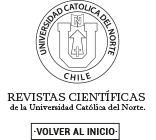Manejo de recursos y coexistencia poblacional en la quebrada de Cobija durante la influencia inca.
Keywords:
asentamientos, cerámica, Inca regional, settlements, ceramics, Regional Inca.Abstract
El estudio de los asentamientos Cobija-1 y Cobija-2 nos ha permitido discutir la interacción social que se llevó a cabo en la serranía de Arica entre los años 1400 DC a 1500 DC, según las fechas obtenidas por termoluminiscencia. Del análisis de la cerámica y la arquitectura se desprende que dichos asentamientos fueron edificados con el propósito de explotar agrícolamente y controlar los recursos hídricos de la quebrada de Cobija. Esta situación habría generado una coexistencia poblacional entre grupos nativos de la sierra y otro que llegó en representación del Estado inca, posiblemente de origen altiplánico.
Abstract
Against the chronological background provided by TL-dated pottery, research undertaken in the sites of Cobija-1 and Cobija-2 leads to consider the social interactions that occurred in the sierras of Arica between 1400 AD and 1500 AD. From the analysis of both ceramic remains and architecture, we consider that these settlements were built with the simultaneous purpose of controlling water resources, and exploiting agricultural produce in the valley of Cobija. We argue that this situation generated forms of population coexistence between native groups of the sierra, and people coming from the Andean high plains in representation of the Inca State.
Downloads
Downloads
Published
Issue
Section
License

All works published in Revista Estudios Atacameños (ISSN on line:0718-1043) Revista Estudios Atacameños Creative Commons International 4.0 attribution (CC BY 4.0) licence.
Authors remain the owners of their work and may republish their articles elsewhere without having to request permission, as long as they indicate that the work was originally published in Revista Estudios Atacameños (ISSN on liine:0718-1043).












